2021.06.01.30
Files > Volume 6 > Vol 6 No 1 2021
Patricia Isabel Manzano - Santana1,2,5*, Juan Pablo Peñarreta Tivillin1, Iván Andrés Chóez-Guaranda1, Ana Délida Barragán Lucas1, Andrea Katherine Orellana - Manzano2,3, Luca Rastrelli4
Available from: http://dx.doi.org/10.21931/RB/2021.06.01.30
ABSTRACT
Nowadays, COVID-19 cases are growing worldwide, and there is no evidence of an effective drug to combat the new SARS-CoV-2 virus. In this sense, medicinal plants as an alternative treatment are being used without control to handle the pandemic situation. Therefore, bioactive compounds against Coronavirus of medicinal plant species that grow in Ecuador are discussed. The plant species described in this review are Azadirachta indica, Cinchona pubescens, Coriandrum sativum, Cúrcuma longa, Eucalyptus spp, Morus alba, and Salvia rosmarinus[A3] ; and compunds are curcumin, coriandrin, deoxynojirimycin, kuwanon G, mulberroside A, oleanolic acid, rosmarinic acid, ursolic acid, quinine, eucalyptol, and jensenone.
Keywords: bioactivity, Coronavirus, COVID-19, medicinal plants, SARS-CoV-2
INTRODUCTION
SARS-CoV-2, the virus that causes coronavirus disease 2019 (COVID-19), is a new type of Coronavirus that currently has claimed 5,682,389 of infected people and 354,944 deaths globally. In Ecuador, the facts are also alarming, with 38,103 confirmed cases and 3,275 deaths1.
The development of treatments to combat this terrible global pandemic is still under study by the scientific community because therapeutic options are not effective2. Different combinations of medicines are being assessed without considering possible adverse effects and interactions due to health emergencies.
In contrast, in some megadiverse countries as Ecuador, the population targets the use of medicinal plants as an alternative treatment due to about 3000 medicinal plant species that are not being used properly3. Thus, this work describes a list of different compounds belonging to medicinal plant species that grow in Ecuador with potential bioactivity against new SARS-CoV-2.
BACKGROUND
Medicinal plants species
Cúrcuma longa[A5] L.
Turmeric, possibly originating from India and belonging to the Zingiberacea family[A6] , is an evergreen herbaceous plant that grows mainly in India and China. The plant is distributed throughout the tropics and subtropical regions of the world4. The presence of various metabolites such as curcuminoids, oil content, flavonoids, phenolics, amino acids, proteins, and alkaloids reveals a correlation with their medicinal uses. Curcumin has been classified as Generally recognized as safe (GRAS) by the United States Food and Drug Administration (FDA), which means that the addition in food is considered safe5. Curcumin has been shown to have antiviral activity; it has acted as an efficient inhibitor of Epstein-Barr virus (EBV[A7] [A8] [A9] )[A10] 6–11 and Human Immunodeficiency Virus (HIV). Also, it has inhibited the HIV-1 integrase necessary for viral replication4.
Moreover, this compound has been studied as an antiviral agent against HIV, herpes simplex virus (HSV), hepatitis viruses, influenza type A virus (IAV[A11] )12, and Ebola virus13. The potential activity of curcumin against SARS-CoV- 2 has been demonstrated by14, using the molecular docking method to determine the affinity of binding between the active molecule and COVID-19 proteases[A12] 15,16. 6LU7 AND 6Y2E expressed in kcal/mol obtain favorable results and recommend the plant species for future studies[A13] 17–19. Due to its various properties, curcumin has the potential for the development of new drugs4.
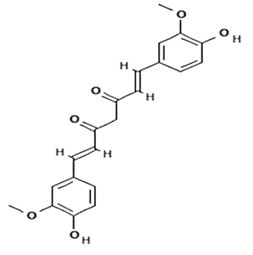
Figure 1. Curcumin: C21H20O6
Coriandrum sativum[A14] L.
It belongs to a large family [A15] (apiaceae) of flowering plants, which belong to 455 genera distributed mostly in temperate zones, known as "Cilantro[A16] " 20. It is an annual plant native to the Mediterranean and the Middle East Regions21. A study assessed with hexane and aqueous extracts of the seed has revealed inhibition of 99 and 95% of Herpes Simplex with at a concentration of 500 ug / mL, demonstrating antiviral properties21 The potential activity against SARS-Cov-2 of the Coriandrin[A17] 22,23, a component of C. sativum has been demonstrated by molecular docking, using the COVID-19 6LU7 and 6Y2E proteases of the Coronavirus as binding targets obtaining optimal results14. SARS-CoV and SARS-CoV-2 are comparable at their receptors, such as the receptor-binding domain (RBD) and the receptor-binding motif (RBM) in the viral genome[A18] 24–26. Consequently, Angiotensin-Converting Enzyme 2 (ACE2) gets connected to RBM of the S protein when SARS affects27,28. Extracts of Coriandrum sativum leaves have been reported to have different flavonoids, inhibit an angiotensin-converting enzyme activity, and prevent various cardiovascular disorders29.
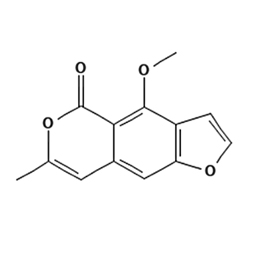
Figure 2. Coriandrin: C13H10O4
Eucalucalyptus L'Hér
It is native to Australia and Tasmania, with some species identified in New Guinea, the Philippines, and Indonesia[A19] 30. The widest plant genus belongs to the Myrtacea family, covering 90% of the tropical areas established in 1955. [A20] It was first cultivated outside its native habitat in Portugal, and then it was subsequently widely distributed in Europe, Latin America, Asia, and Africa. Among the most prominent countries are United States, Ecuador, Colombia, Chile, China, Spain, Israel, Ethiopia, Morocco, South Africa, and Uganda31. The essential oils of Eucalyptus L'Héare known to be rich in a monoterpene for medicinal use called eucalyptol (1,8-cineole)32,33.[A21] Varieties such as Eucalyptus globulus have been demonstrated possess in their chemical composition eucalyptol (63.81%)[A22] [A23] 34, pinene [A24] (16.06%), aromadendrene (3.68%), and o.-cymene (2.35%)33. Eucalyptol is an organic, liquid, and colorless compound. It is a cyclic ether and a monoterpenoid35. Eucalyptus extract has been shown activity against SARS-CoV at the concentration of 100 µM, similar to the Ginsenoside-Rb1, one of the traditional Chinese herb's pharmacologically active components Panax ginseng36,37. A potential activity against SARS-Cov-2 of the molecules Eucalyptol and Jensenone was demonstrated [A25] by molecular docking using the main protease (Mpro) / chymotrypsin-like known as protease (3CLpro) of COVID-19 as a binding target, represents a potential target for inhibition of Coronavirus replication38–40. Since it plays a vital role in the necessary processing of polyproteins in the replication of Coronavirus, this affinity of the Eucalyptol and Jensenone molecules should be studied in more detail for their potential use as SARS-CoV-2 inhibitors35.
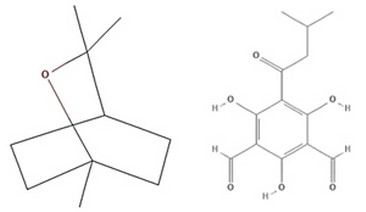
Figure 3. Eucalyptol: C10H18O; Jensenone: C13H14O6
Morus alba[A26] L.
The Morus genus belongs to the Moracea family [A27] and has 24 species of at least 100 varieties. However, Morus spp has spread throughout the world[A28] 41. It is believed that its origin is in Asia. Morus species are known for their medicinal uses as antibacterial and antifungal properties reported in many regions of the world. Molecules such as flavonoids, benzofurans, stilbenes, polyhydroxy alkaloids, and kiwanons are responsible for this pharmacological properties42. Studies in Morus alba have determined 1- deoxynojirimycin, which has antiviral effects against the hepatitis B and C viruses43,44.[A29] The juice and seeds of this plant species can have a positive impact on human health since it is rich in polyphenols, which are responsible for multiple biological activities, such as antiviral activity against influenza virus strains A / Brisbane / 59/2007 (H1N1), pandemic A / Korea / 01/2009 (H1N1) and B / Florida / 4 / 200645. The anti-Human Coronavirus (HCoV)[A30] 42 229E properties were demonstrated by the cytopathogenic effect's in vitro antiviral activity, favorable results were obtained for the 1-deaoxynojirimycin, kuwanon G, mulberroside A molecules present in the Morus alba species. These molecules' antiviral mechanisms require additional studies to determine whether they are based on blocking viral entry into the host cell or inhibiting viral replication42.
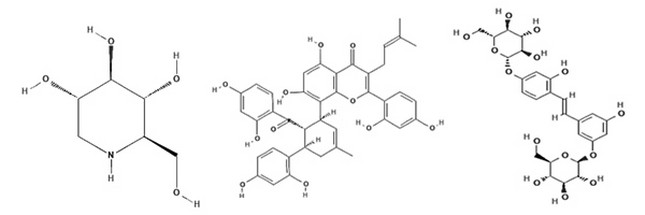
Figure 4. 1 Deoxynojirimycin: C6H13NO4; Kuwanon G: C40H36O11; Mulberroside A: C26H32O14
Salvia Rosmarinus[A31] L.
This aromatic plant with needle-shaped leaves belongs to the Lamiaceae family[A32] , and it is cultivated throughout the world46.[A33] Rosemary has therapeutic properties and has been used in popular medicine as antifungal, antibacterial, anti-inflammatory, anti-tumor, antithrombotic, antiviral, antidepressant antioxidant47,48. [A34] [A35] Some flavonoids have been identified (eriocitrin, luteolin 3'-O- β-D-glucuronide, hesperidin, diosmin, isoscutellarein 7-O-glucoside, hispidulin 7-O-glucoside, and genkwanin)49,50.[A36] Other molecules described with potential bioactivity are carnosol, carnosic, rosmaric, ursolic, oleanolic, and micrometric acid47. The Oleanolic acid, rosmarinic acid, and ursolic acid were used to determine the antiviral activity against SARS-CoV-2[A37] 51–53 by molecular docking analysis, obtaining favorable results and establishing these molecules as potential inhibitors of the SARS-CoV-2 virus14.

Figure 5. Oleanolic acid: C30H48O3; Rosmarinic acid: C18H16O8; Ursolic acid: C30H48O3
Azadirachta indica[A38] A. Juss
Belonging to the Meliacea family[A39] , this plant has been used to cure multiple diseases in different parts of Asia and Africa, one of the first plants mentioned in Siddha medicine, the oldest medical system known to humanity54. In vivo studies with aqueous extract have revealed that the maximum non-toxic concentrations of 120-30 mg/mL resulted [A40] in inhibiting the virus replication (Dengue Virus type-2)55. Polyphenolic flavonoids extracted from fresh Neem leaves show antibacterial and antifungal activities. On the other hand, the extract of Neem bark at a variable concentration of 50 to 100 µg / mL can stop the entry of Herpes Virus Simplex (HSV-1) into cells56. This plant's use in treating infections of various viruses such as poliovirus, bovine herpesvirus type 1, duck plague virus has also been reported57. Molecules present in this plant species, such as Nimbaflavone, rutin, and Hyperoside, have shown a potential inhibition in influenza viruses (H1N1, H1N2, H2N2, H2N3, H5N1, H7N2, H7N3, H7N7, and H9N2) by exhibiting extensive antiviral properties58.

Figure 6. Nimbaflavone: C26H30O5; Rutina: C27H30O16; Hyperoside: C21H20O12
Cinchona pubescens[A41] Vahl
It is one of the 23 species of the Cinchona genus[A42] that belongs to the Rubiacea family[A43] . It has widely been introduced in many parts of the world as Bolivia, Colombia, Ecuador, and Peru for its source of quinine59. Quinine is the component of a popular malarial drug, but despite being useful in malaria, its bark has an unacceptable risk of toxicity due to a lack of optimization in the quinine dose60. Potential anti-SARS-CoV-2 inhibition of the quinine molecule has been demonstrated by molecular docking analysis using the 6LU7 COVID-19 protease as a target. The results are recommending the molecule for further studies for its potential inhibition56.
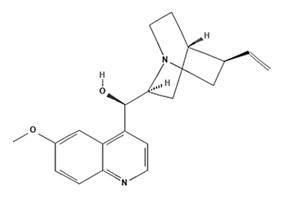
Figure 7. Quinine: C20H24N2O2
Potential bioactive compounds
Table 1 details the studies on compounds from medicinal plants that grow in Ecuador with potential inhibition against SARS-CoV-2. The species Azaradichta indica is included in this list despite not reporting studies for this virus due to the number of biological evaluations carried out as antiviral.
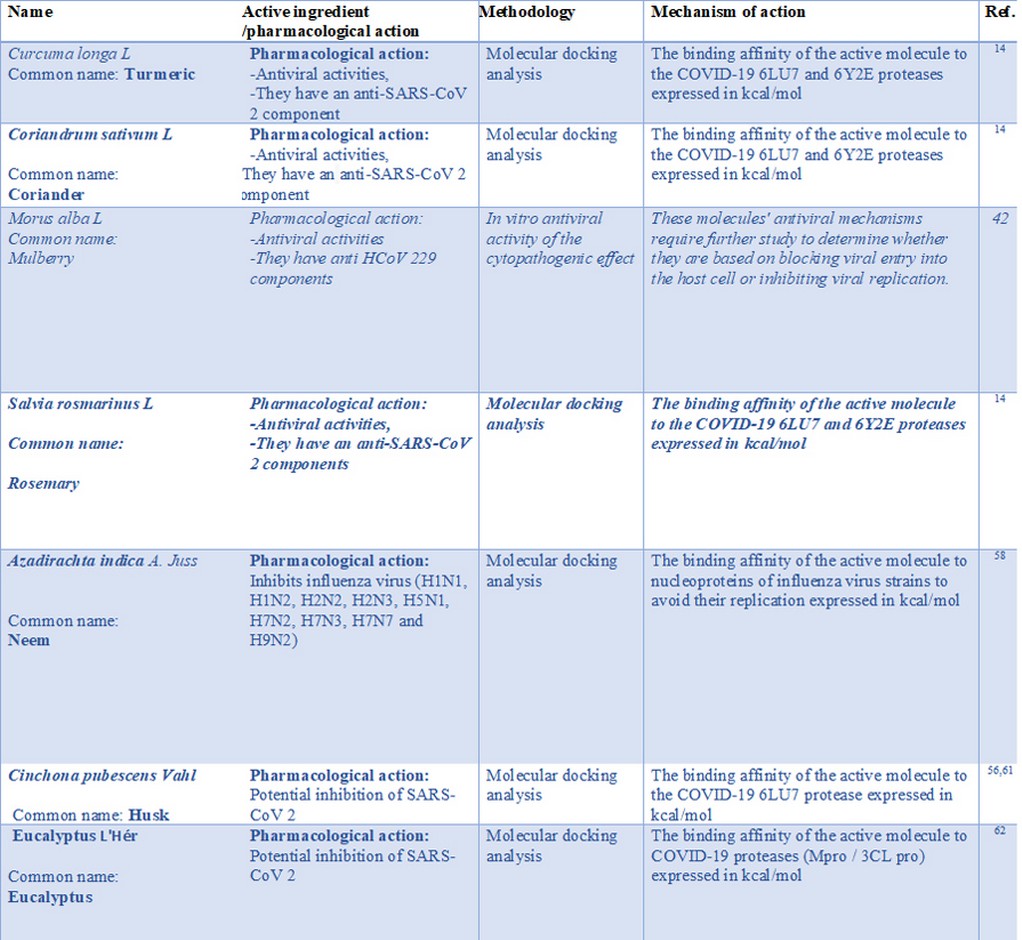
Table 1. Bioactive compounds with potential inhibition against SARS-CoV-2.
CONCLUSIONS
Seven medicinal plants that grow in Ecuador have potential use for the treatment of COVID-19: Azadirachta indica, Cinchona pubescens, Coriandrum sativum, Cúrcuma longa, Eucalyptus spp, Morus alba, Salvia rosmarinus. The literature reported for these species 11 bioactive compounds against SARS-Cov-2. This report provides a baseline for further studies to validate the antiviral potential of these plant species.
Funding: This research is funded by the Center for Biotechnological Research of Ecuador to be part of its research lines.
Conflicts of Interest: The authors declare no conflict of interest.
REFERENCES
1. Ministerio de Salud Pública. Actualización de casos de coronavirus en Ecuador. 2020.
2. Pan American Health O. Ongoing living update of potential COVID-19 therapeutics: summary of rapid systematic reviews. 2020:17.
3. Vacas C, Medina D, Íñiguez J, Navarrete H. Los Kichwas del Alto Napo y sus plantas medicinales. edipuce. 2017. 112 p.
4. Vigyan Kendra K, Preeti Kumari I, Kumar Maurya Scholar R, Kumar V, Kumar Verma R, Kumari P, et al. Medicinal properties of turmeric (Curcuma longa L.): A review. Int J Chem Stud. 2018.6(4):1354–7.
5. FDA. Summary of safety data and food usage conditions for conclusion of general recognition of safety of BCM-95® (Curcumin). Landing; 2016.
6. Lv Y, Gong L, Wang Z, Han F, Liu H, Lu X. et al. Curcumin inhibits human cytomegalovirus by downregulating heat shock protein 90. Mol Med Report. 2015.12:4789–4793. doi: 10.3892/mmr.2015.3983.
7. Ranjan D, Siquijor A, Johnston T, Wu G et al. The effect of curcumin on human B-cell immortalization by Epstein-Barr virus / Discussion. In: Atlanta. 1998. p. 47–51.
8. Kapadia G, Azuine M, Tokuda H, Hang E, Mukainaka T, Nishino H. Inhibitory effect of herbal remedies on 12-o-tetradecanoylphorbol-13-acetate-promoted Epstein–Barr virus early antigen activation. Pharmacol Res. 2002.45(3):213–20. doi: doi.org/10.1006/phrs.2001.0936.
9. Praditya D, Kirchhoff L, Brüning J, Rachmawati H, Steinmann J. Anti-infective properties of the golden spice curcumin. Front Microbiol. 2019.10:912. doi: 10.3389/fmicb.2019.00912.
10. Ali A, and Banerjea A. Curcumin inhibits HIV-1 by promoting tat protein degradation. Sci Rep. 2016.6:27539. doi: 10.1038/srep27539.
11. Lin X, Ammosova T, Kumari N, and Nekhai S. Protein phosphatase-1 -targeted small molecules, iron chelators and curcumin analogs as HIV-1 antivirals. Curr Pharm Des. 2017.23:4122–4132. doi: 10.2174/1381612823666170704123620.
12. Han S, Xu J, Guo X, and Huang M. Curcumin ameliorates severe influenza pneumonia via attenuating lung injury and regulating macrophage cytokines production. Clin Exp Pharmacol. 2018.45:84–93. doi: 10.1111/1440-1681.12848.
13. Mathew D, Hsu W. Antiviral potential of curcumin. J Funct F. 2018.40:692–9.
14. Sampangi-ramaiah MH, Vishwakarma R, Shaanker RU. Molecular docking analysis of selected natural products from plants for inhibition of SARS-CoV-2 main protease. Curr. 2019.:1087–92. 10.18520/cs/v118/i7/1087-1092.
15. Sourav D, Sharat S & ASR. An investigation into the identification of potential inhibitors of SARS-CoV-2 main protease using molecular docking study. J Biomol Struct Dyn. 2020. doi: 10.1080/07391102.2020.1763201.
16. Tien H, Haoran W. In Silico Exploration of Molecular mechanism of clinically oriented drugs for possibly inhibiting SARS-CoV-2's Main Protease. J Phys Chem Lett. 2020.1–26. doi: 10.1021/acs.jpclett.0c00994.
17. Nivetha R, Bhuvaragavan S et al. Inhibition of multiple SARS-CoV-2 proteins by an antiviral biomolecule, seselin from Aegle marmelos deciphered using molecular docking analysis. Res Sq. 2020. doi: 10.21203/rs.3.rs-31134/v1.
18. Jiménez G, Vargas A, Delgado N, Gustavo E. Olivos G, Sheen P, Manolo P. High-Throughput Virtual Screening of 4487 flavonoids: New insights on the structural inhibition of SARS-CoV-2 Main Protease. arXiv Biomol. 2020.
19. Adhikari N, Amin S. dissecting the drug development strategies against SARS-CoV-2 through diverse computational modeling techniques. in: . methods in pharmacology and toxicology. Springer. 2020. doi: https://doi.org/10.1007/7653_2020_46.
20. Morales P. Herbs and leaf crops: Cilantro, Broadleaf Ilantro, and vegetable Amaranth. Encycl Life Support Syst Soils, plant growth Crop Prod United Nations Educ Sci Cult Organ. 2011.
21. Fayyad A, Ibrahim N, Yaakob W. Evaluation of biological activities of seeds of Coriandrum sativum. Int J Sci Eng Res. 2017.8(7):1058-1063.
22. Kumar S, Kashyap P, Chowdhury S, Kumar S, Panwar A. Identification of phytochemicals as potential therapeutic agents that binds to Nsp15 protein target of Coronavirus (SARS-CoV-2) that are capable of inhibiting virus replication. Phytomedicine. 2020. doi: https://doi.org/10.1016/j.phymed.2020.153317.
23. Das G, Ghosh S, Garg S, Ghosh S, Jana A, Samat R, Ghosh S. An overview of key potential therapeutic strategies for combat in the COVID-19 battle. RSC Adv. 2020.10(47):28243–28266. doi: 10.1039/D0RA05434H.
24. Lan J, Ge J, Yu J, Shan S, Zhou H, Fan S, Zhang Q, Shi X, Wang Q. Structure of the SARS-CoV-2 spike receptor-binding domain bound to the ACE2 receptor. Nature. 2020.(581):215–20. doi: https://doi.org/10.1038/s41586-020-2180-5.
25. Letko M, Marzi A & Munster V. Functional assessment of cell entry and receptor usage for SARS-CoV-2 and other lineage B betacoronaviruses. Nat Microbiol. 2020.(5):562–569. doi: https://doi.org/10.1038/s41564-020-0688-y.
26. Yi C, Sun X, Ye J et al. Key residues of the receptor binding motif in the spike protein of SARS-CoV-2 that interact with ACE2 and neutralizing antibodies. Cell Mol Immunol. 2020.(17):621–630. doi: https://doi.org/10.1038/s41423-020-0458-z.
27. Tai W, He L, Zhang X, Pu J, Voronin D, Jiang S, et al. Characterization of the receptor-binding domain (RBD) of 2019 novel Coronavirus: implication for development of RBD protein as a viral attachment inhibitor and vaccine. Cell Mol Immunol. 2020. doi: 10.1038/s41423-020-0400-4.
28. Zhang L, Lin D, Sun X, Curth U, Drosten C, Sauerhering L, et al. Crystal structure of SARS-CoV-2 main protease provides a basis for design of improved a-ketoamide inhibitors. Science (80- ). 2020.368(6489):409–12. doi: 10.1126/science.abb3405.
29. Hussain F, Jahan N, Rahman K-, Bushra S, Saba J. Identification of Hypotensive Biofunctional Compounds of Coriandrum sativum and Evaluation of Their Angiotensin-Converting Enzyme (ACE) Inhibition Potential. Oxid Med Cell Longev. 2018. doi: 10.1155/2018/4643736.
30. Timothy D. Paine, Martin J. Steinbauer SAL. Native and exotic pests of Eucalyptus: A worldwide perspective. Annu Rev Entomol. 2011.56:181–201. doi: https://doi.org/10.1146/annurev-ento-120709-144817.
31. Bayle G. Ecological and social impacts of eucalyptus tree plantation on the environment. J biodivers Conserv bioresour Manag. 2019.5(1):93–104. doi: https://doi.org/10.3329/jbcbm.v5i1.42189.
32. Mulyaningsih S, Sporer F, Reichling J, Wink M. Antibacterial activity of essential oils from Eucalyptus and of selected components against multidrug-resistant bacterial pathogens. Pharm Biol. 2011.49(9):893–9. doi: 10.3109/13880209.2011.553625.
33. Ângelo L, Duarte A, Gominho J, Domingues F. Chemical composition, antioxidant, antibacterial and anti-quorum sensing activities of Eucalyptus globulus and Eucalyptus radiata essential oils. Ind Crops Prod. 2016.79:274–82. doi: https://doi.org/10.1016/j.indcrop.2015.10.055.
34. Boukhatem M, Boumaiza A, Nada H, Rajabi M. Eucalyptus globulus essential oil as a natural food preservative: antioxidant, antibacterial and antifungal properties In vitro and in a real food matrix (orangina fruit juice). Appl Sci. 2020.10:5581. doi: https://doi.org/10.3390/app10165581.
35. Sharma A, Kaur I. Eucalyptol (1,8 cineole) from Eucalyptus esssential oil a potential inhibitor of COVID 19 corona virus infection by Molecular docking studies. Preprints. 2020.59–66. doi: 10.20944/preprints202003.0455.v1.
36. Helms S. Cancer prevention and therapeutics: Panax ginseng. undefined. 2004.
37. Wu C, Jan J, Ma S, Kuo C, Juan H, Cheng Y, et al. Small molecules targeting severe acute respiratory syndrome human Coronavirus. Proc Natl Acad Sci U S A. 2004.101(27):10012–7. doi: 10.1073/pnas.0403596101.
38. Arun D, Sharma I. Eucalyptus essential oil bioactive molecules from against SARS-CoV-2 spike protein: Insights from computational studies. Res Sq. 2021. doi: https://doi.org/10.21203/rs.3.rs-140069/v1.
39. Jahan I. Potentials of plant-based substance to inhabit and probable cure for the COVID-19. Turk J Biol. 2020.44(3):228–41. doi: 10.3906/biy-2005-114.
40. Asif M, Saleem M, Saadullah M. COVID-19 and therapy with essential oils having antiviral, anti-inflammatory, and immunomodulatory properties. Inflammopharmacol. 2020.28:1153–61. doi: https://doi.org/10.1007/s10787-020-00744-0.
41. Vijayan K, Ravikumar G. TA. Mulberry (Morus spp.) Breeding for Higher Fruit Production. In: Al-Khayri J., Jain S., Johnson D. (eds) Advances in Plant Breeding Strategies: Fruits. Springer, Cham. 2018.
42. Thabti I, Albert Q, Philippot S, Dupire F, Westerhuis B, Fontanay S, et al. Advances on Antiviral Activity of Morus spp. Plant Extracts: Human Coronavirus and Virus-Related Respiratory Tract Infections in the Spotlight. Molecules. 2020.25:1876. doi: https://doi.org/10.3390/molecules25081876.
43. Liu C, Xiang W, Yu Y, Zheng-Qin S, Xian-Zhi H. Comparative analysis of 1-deoxynojirimycin contribution degree to α-glucosidase inhibitory activity and physiological distribution in Morus alba L. Ind Crops Prod. 2015.70:309–15. doi: https://doi.org/10.1016/j.indcrop.2015.02.046.
44. James J, Keith M, Jung-Eun Y, Tennant T. Natural Iminosugar Derivatives of 1-Deoxynojirimycin Inhibit Glycosylation of Hepatitis Viral Envelope Proteins. J Microbiol. 2007.45(5):431–40.
45. Kim H, Chung MS. Antiviral activities of mulberry (Morus alba) juice and seed against influenza viruses. Evidence-based Complement Altern Med. 2018. doi: 10.1155/2018/2606583.
46. Ribeiro R, Carvalho D, Cavaleiro C, Costa H, Gonçalves T, ConceiçãoM, Ramos F, Melo N. A novel insight on an ancient aromatic plant: The rosemary (Rosmarinus officinalis L.). Trends Food Sci Technol. 2015.45(2):355–68. doi: https://doi.org/10.1016/j.tifs.2015.07.015.
47. Macedo L, Mendes É, Milit L, Tundisi L, Souto E, Mazzola P. Rosemary (Rosmarinus officinalis L., syn Salvia rosmarinus Spenn.) and Its Topical Applications: A Review. Plants. 2020.9 (5)(651):1–12. doi: https://doi.org/10.3390/plants9050651.
48. Patel A, Tiwari S, Pandey N, Gupta D, & Prasad S. Role of spices beyond a flavouring agent: the antioxidant and medicinal properties. Ethnopharmacol Investig Indian Spices. 2020.5–35. doi: 10.4018/978-1-7998-2524-1.ch002.
49. del Baño M, Lorente J, Castillo J, Benavente O, Piedad M, Del Río J, Ortuño A. Flavonoid distribution during the development of leaves, flowers, stems, and roots of Rosmarinus officinalis. Postulation of a biosynthetic pathway. J Agric Food Chem. 2004.52(16):4987–4992. doi: https://doi.org/10.1021/jf040078p.
50. Al-Snafi A. Phenolics and flavonoids contents of medicinal plants, as natural ingredients for many therapeutic purposes- A review. IOSR J Pharm. 2020.10(7):42–81.
51. Maurya D. Evaluation of traditional ayurvedic preparation for prevention and management of the novel Coronavirus (SARS-CoV-2) using molecular docking approach. ChemRxiv. 2020. doi: https://doi.org/10.26434/chemrxiv.12110214.v1.
52. Adithya J, Bhagyalakshmi, Aishwarya S, Nath LR. The plausible role of indian traditional medicine in combating corona virus (SARS-CoV 2): a mini-review. Curr Pharm Biotechnol. doi: https://doi.org/10.2174/1389201021666200807111359.
53. Pawełczyk A, & Zaprutko L. Anti-COVID drugs: repurposing existing drugs or search for new complex entities, strategies and perspectives. Futur Med Chem. 12(19). doi: https://doi.org/10.4155/fmc-2020-0204.
54. Gupta S, Prasad S, Tyagi A KA& AB. Neem (Azadirachta indica): An indian traditional panacea with modern molecular basis. Phytomedicine. 2017.34:14–20.
55. Parida M, Upadhyay C, Pandya G & JA. Inhibitory potential of neem (Azadirachta indica Juss) leaves on dengue virus type-2 replication. J Ethnopharmacol. 2002.79(2):273–8. doi: https://doi.org/10.1016/S0378-8741(01)00395-6.
56. Srivastava A, Kumar A, Tiwari G, Kumar R, Misra N. In Silico Investigations on the Potential Inhibitors for COVID-19 Protease. Preprints. 2020.1–12.
57. Tripathi A, Sinha S. y Dwivedi B. Tripathi A, Sinha S, & Dwivedi B. An Attempt to Evaluate Antiviral Activity of Plant Extracts to Combat Infections Caused by Viruses Including SARS COV-2. 2020. http://dx.doi.org/10.2139/ssrn.3599444.
58. Ahmad A, Javed M, Rao A, Husnain T. Designing and screening of universal drug from neem (Azadirachta indica) and standard drug chemicals against influenza virus nucleoprotein. BMC Complement Altern Med. 2016.16(1):1–8. doi: 10.1186/s12906-016-1469-2.
59. Jäger H. Quinine tree invasion and control in Galapagos: A Case Study. In: Torres M, Mena C, editors. Understanding invasive species in the Galapagos Islands. Springer, Cham; 2018. p. 69–76.
60. Faisal R, Shinwari L, Aziz I, Khalil AT. Therapeutic and adverse effects of commonly used medicinal plants: Standardization and quality assurance. Proc Pakistan Acad Sci Part B. 2019.56(3BSpecial Issue):1–9.
61. Jomsky M. Could low-dose quinine prevent or treat coronavirus infection? EC Pharmacol Toxicol. 2020.(March):6–9.
62. Sharma A, Kaur I. Molecular docking studies on Jensenone from Eucalyptus essential oil as a potential inhibitor of COVID 19 corona virus infection. Preprints. 2020.(March). doi: 10.20944/preprints202003.0455.v1.
Received: 15 December 2020
Accepted: 20 January 2021
Patricia Isabel Manzano - Santana1,2,5*, Juan Pablo Peñarreta Tivillin1, Iván Andrés Chóez-Guaranda1, Ana Délida Barragán Lucas1, Andrea Katherine Orellana - Manzano2,3, Luca Rastrelli4
1 Centro de Investigaciones Biotecnológicas del Ecuador, ESPOL Polytechnic University, Escuela Superior Politécnica del Litoral, ESPOL, Campus Gustavo Galindo Km. 30.5 vía Perimetral, P.O. Box 09-01-5863, Guayaquil, Ecuador.
2 Laboratorio para investigaciones biomédicas, Facultad de Ciencias de la Vida, ESPOL Polytechnic University, Escuela Superior Politécnica del Litoral, ESPOL, Campus Gustavo Galindo Km. 30.5 vía Perimetral, P.O. Box 09-01-5863, Guayaquil, Ecuador.
3 Universidad de Especialidades Espíritu Santo, Escuela de Odontología, Samborondón, Guayas, Ecuador.
4 Departamento de Ciencias Biomédicas y Farmacéuticas, Universidad de Salermo, Italia.
5 Facultad de Ciencias Naturales y Matemáticas, ESPOL Polytechnic University, Escuela Superior Politécnica del Litoral, ESPOL, Campus Gustavo Galindo Km. 30.5 vía Perimetral, P.O. Box 09-01-5863, Guayaquil, Ecuador.
Corresponding author: [email protected]
